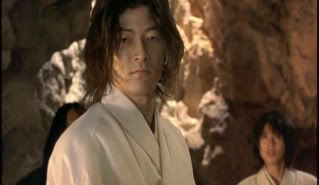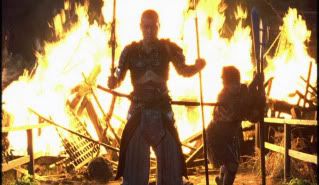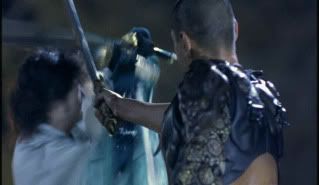
Director Sogo Ishii is best known for his radical style and rather frenetically paced films. His early involvement the burgeoning punk scene in Tokyo combined with a love of performance art is clearly visible in some of his early work such as the early biker-punk / bōsōzoku cult classics like Burst City (1982) and Crazy Thunder Road (1980) (previously reviewed in this very blog by my esteemed coleague, Ash) as well the school siege film, Panic in High School (1978), a motion picture that is shockingly relevant today given the tragic events at Columbine and Virginia Tech.
I personally never thought that I'd see the day where Ishii would test the tried and true waters of jidai geki, but here we are.
Ishii's goal seems to be to take a well worn folk tale and give it a fresh coat of paint. In this case, Ishii really does go out of his way emphasize the more cosmic and philosophical elements of the story and transforms a duel between two men into a clash of elemental forces.

I personally never thought that I'd see the day where Ishii would test the tried and true waters of jidai geki, but here we are.
Ishii's goal seems to be to take a well worn folk tale and give it a fresh coat of paint. In this case, Ishii really does go out of his way emphasize the more cosmic and philosophical elements of the story and transforms a duel between two men into a clash of elemental forces.

In this case, the well worn folk tale in question is that of the legendary duel between Musashi-bo Benkei and Minamoto no Yoshitsune at Gojoe Bridge.
The story is set in 12th century Japan during the rather violent transition in power between the declining nobility and the rapidly rising Samurai class. We find ourselves viewing the aftermath of a brutal feud between the Heike and Genji clans. The Heike have emerged victorious, but the conflict has taken a toll on its military might.
To make matters worse, the remaining Heike have found themselves the target of a bloodthirsty demon known as Shanao that haunts Gojoe Bridge which lies on the outskirts of Kyoto. Night after night, Heike soldiers are found beheaded and the heavens are rife with ill omens.

The story is set in 12th century Japan during the rather violent transition in power between the declining nobility and the rapidly rising Samurai class. We find ourselves viewing the aftermath of a brutal feud between the Heike and Genji clans. The Heike have emerged victorious, but the conflict has taken a toll on its military might.
To make matters worse, the remaining Heike have found themselves the target of a bloodthirsty demon known as Shanao that haunts Gojoe Bridge which lies on the outskirts of Kyoto. Night after night, Heike soldiers are found beheaded and the heavens are rife with ill omens.

Shortly thereafter, we're introduced to Musashi-Bo Benkei (Daisuke Ryu) and learn that he is a man with a very troubled past. A former bandit, Benkei has turned to Buddhism in order to find enlightenment for his turbulent soul, but he can find no solace whatsoever. In desperation, Benkei decides that the only way to exorcise his personal demons is to defeat a worldly demon, so he ventures to Kyoto to confront Shanao.


Despite his bestial appearance, Shanao turns out to be quite human and in actuality is Minamoto no Yoshitsune (Tadanobu Asano); the last surviving member of the Genji. Yoshitsune is the mirror opposite of Benkei in that his plan is to exorcise evil from the world (i.e. the remaining members of the Heike clan) by fully embracing the darkness within his heart.


Naturally, it is only a matter of time before two such forces collide. Despite the flashy special effects and heavily choreographed fight scenes, Ishii manages to weave together a fairly convincing tale of two determined combatants fated to do battle in the course of pursuing their own personal destinies and the climax of this conflict is enjoyable if not somewhat predictable.
Mechanically, Gojoe is a rather ambitious piece of work but ends up being a slightly muddled hydra of a project. Fans and scholars of jidai geki can tell you that modern samurai period pieces are far more violent than their predecessors but plot wise, they are not nearly as philosophically progressive as the highly critical and taboo smashing samurai films of the Sixties.
Gojoe attempts to reach the lofty heights of angry and socially confrontational works such as Sword of Doom (1966) and Harakiri (1962), while still retaining the fountains of blood from films such as Beat Takeshi's Zatôichi (2003) or Sonny Chiba violence parties like Shogun's Ninja (1980) that latter day viewers have come to expect.
Sadly, Gojoe tries to juggle too much for two long of a period of time (runtime is a whopping two and a half hours) and ultimately suffers for it.

Mechanically, Gojoe is a rather ambitious piece of work but ends up being a slightly muddled hydra of a project. Fans and scholars of jidai geki can tell you that modern samurai period pieces are far more violent than their predecessors but plot wise, they are not nearly as philosophically progressive as the highly critical and taboo smashing samurai films of the Sixties.
Gojoe attempts to reach the lofty heights of angry and socially confrontational works such as Sword of Doom (1966) and Harakiri (1962), while still retaining the fountains of blood from films such as Beat Takeshi's Zatôichi (2003) or Sonny Chiba violence parties like Shogun's Ninja (1980) that latter day viewers have come to expect.
Sadly, Gojoe tries to juggle too much for two long of a period of time (runtime is a whopping two and a half hours) and ultimately suffers for it.

I've seen other reviews of this film that are savagely critical of the apparent lack of character development, but I personally am rather fond of it. It is easy to fall into the trap of morality labeling if you find yourself investing a substantial amount of emotion in one character or another.
In Gojoe, Ishii merely presents the events as they are and doesn't lead you by the nose by telling you whom you should consider to be good or evil.
Both Benkei and Minamoto are equal parts saint and sinner, and the genius of this movie is watching while contradictory yet balancing forces from within and without coalesce from seemingly chaotic fury into one perfect and brutal snapshot in time.
The duel at Gojoe Bridge.

In Gojoe, Ishii merely presents the events as they are and doesn't lead you by the nose by telling you whom you should consider to be good or evil.
Both Benkei and Minamoto are equal parts saint and sinner, and the genius of this movie is watching while contradictory yet balancing forces from within and without coalesce from seemingly chaotic fury into one perfect and brutal snapshot in time.
The duel at Gojoe Bridge.

Although I really do like this motion picture, I can't completely recommend it to the truly uninitiated. To really appreciate what's going on here requires an already healthy diet of Japanese folklore as well as a sense of scope and direction for the diverging styles of jidai geki over the past few decades.
If it were me, I'd start with the cornerstones of each period in time (Takeshi's Zatôichi and perhaps something from Kurosawa's extensive catalogue) before delving headlong into this particular film.
If it were me, I'd start with the cornerstones of each period in time (Takeshi's Zatôichi and perhaps something from Kurosawa's extensive catalogue) before delving headlong into this particular film.










1 comment:
the last Ishii film I watched, ELECTRIC DRAGON 80,000 V, felt pretty flat. Even so, and despite your tentative recommendation, your review actually made me want to check this out.
Post a Comment